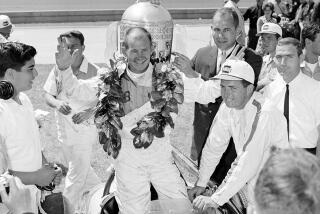Huge Withdrawal Aside, Engine Parity Is the Word
- Share via
The annual game of musical chairs played by drivers drew more attention during CART’s off-season but there was another set of changes that may prove every bit as interesting, involving the 700-plus horsepower turbocharged engines used in the champ car series.
Toyota, which notched its first victories last season, after luring four-time champion owner Chip Ganassi’s team away from Honda, despite Toyota’s previous reputation as an underpowered engine, added to its stable, signing the Pat Patrick and Newman-Haas teams away from 2000 manufacturers’ champion, Ford-Cosworth.
And as Toyota grew in stature, another big name in engines disappeared. Mercedes-Benz withdrew from the series to devote its focus to Formula One. That left Ilmor, which designed and manufactured the engines for Mercedes, with only one team, Brooke-Arciero Racing. The Phoenix, as Ilmor is calling its engine now, basically is the same one that carried the Mercedes nameplate.
Toyota, Ford and Honda are supplying power for nine cars each.
Cristiano da Matta, who replaced Michael Andretti at Newman-Haas, drove one of the team’s Lola-Toyotas to victory in the season opener March 11 at Monterrey, Mexico.
Lee White, vice president and general manager of Toyota Racing Development in Costa Mesa, does not see a clear advantage for any engine manufacturer.
“[The parity] is about as close as it’s ever been in history,” White said. “The engines are extremely close.”
Kevin Kennedy, communications manager for Ford Racing Technology, echoed White.
“The competition level between the three manufacturers is tremendous,” Kennedy said. “The great thing about it is that it’s great for everybody, because it presents tremendous engineering challenges. CART is probably closer between the three manufacturers than any other form of racing.”
Brian Wagner of Honda agreed.
“When you take a look at the off-season testing, everybody was within a tenth of a second of each other,” he said. “We’re all so close, it should prove to be very exciting for the fans.”
White believes that although Honda’s drivers--Paul Tracy, Dario Franchitti, Andretti, two-time series champion Alex Zanardi, defending champion Gil de Ferran, Helio Castroneves, Tony Kanaan, Shinji Nakano and Adrian Fernandez--have the most victories, the Toyota teams of Newman-Haas, Target/Ganassi, Patrick, Pac-West and Derek Walker have an edge in experience. He said that because the engines are so close, the championship battles may boil down to the entire package of teams, engineers, chassis and drivers.
“On the ovals, the Lola [chassis] may have a bit of an edge, and on the full road courses the Reynards might have a bit of an edge,” he said. “We’re not like Honda, which only has Reynards. We have two two-car teams using Reynards and two two-car teams using Lolas, and Derek Walker’s single-car team in a Reynard.”
Ford, which also has teams using both chassis, retained the two-car Players/Forsythe team and Bobby Rahal’s two-car team, and added the Herdez/Bettenhausen team that used Mercedes power in 2000, plus the new teams of Sigma and Zakspeed/Forsythe.
Players/Forsythe, Zakspeed/Forsythe and Sigma run Reynards, while Herdez/Bettenhausen uses Lola, and Rahal switched to Lola from Reynard for 2000.
Ford added two more Reynards when Team PRG partnered with Dale Coyne just before the Monterrey race.
Bruce Wood, Ford-Cosworth program director, said the loss of the Newman-Haas and Patrick teams should not be underestimated but also said the Rahal and Players/Forsythe teams have improved and will fill the void.
“I think Team Rahal has progressed steadily over the last few years and I think with [2000 rookie of the year] Kenny Brack and Max Papis, they have two drivers who are as good as anybody out there,” Wood said.
“Last year, certainly for my money, [Juan] Montoya was better than anybody, and now that he’s gone [to Formula One] I think we have drivers as good as anybody in Max and Kenny, and also in [Players/Forsythe drivers] Patrick [Carpentier] and Alex [Tagliani] as well.”
CART changed three rules for 2001 that affect the engine manufacturers. The maximum turbocharger boost was reduced to 37 inches of pressure from 40, off-season testing was reduced, and in-season testing was all but eliminated.
The Monterrey race showed that parity leads to exciting racing. Of the 28 cars that started the race, 18 still were running at the finish.
Toyota had three cars in the top 10, finishing first, sixth and 10th with Da Matta, Jimmy Vasser of Patrick and Tora Takagi of Walker. Pole-sitter Brack had the lone Ford in the top 10, finishing fifth, and the Hondas of De Ferran, Tracy, Andretti, Castroneves and Franchitti finished second, third, fourth, seventh, eight and ninth.
“If we weren’t going to win the race it’s not a bad consolation prize,” Wagner said of Honda’s showing. “We’re in it for the manufacturers’ championship.”






